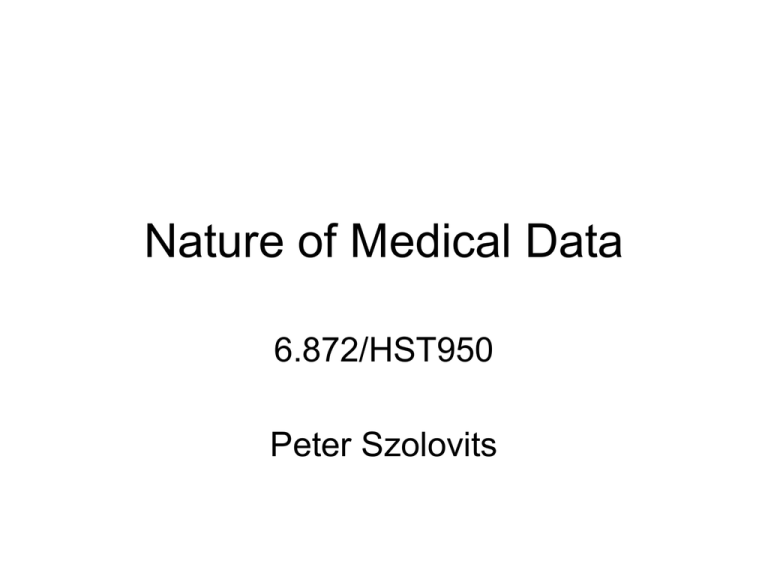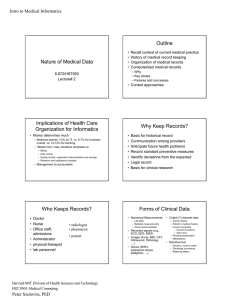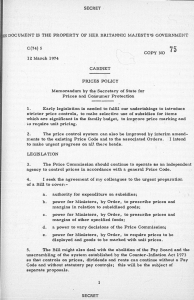Document 13421560
advertisement

Nature of Medical Data 6.872/HST950 Peter Szolovits Outline • • • • Recall context of current medical practice History of medical record keeping Organization of medical records Computerized medical records – Why – Key issues – Failures and successes • Current approaches Implications of Health Care Organization for Informatics • Money determines much – Medicine spends 1-2% on IT, vs. 6-7% for business overall, vs. 10-12% for banking – “Bottom line” rules, therefore emphasis on • • • • Billing Cost control Quality control, especially if demonstrable cost savings Retention and satisfaction (maybe) – Management by accountants Why Keep Records? • • • • • • • Basis for historical record Communication among providers Anticipate future health problems Record standard preventive measures Identify deviations from the expected Legal record Basis for clinical research Who Keeps Records? • Doctor • Nurse • Office staff, admissions • Administrator • physical therapist • lab personnel • radiologist • pharmacist • patient Forms of Clinical Data • Numerical Measurements • Coded (?) discrete data – Lab data – Bedside measurements – Home instrumentation – Family history – Patient’s medical history – Current complaint • Symptoms (patient) • Recorded signals (e.g., • Signs (doc) ECG, EEG, EMG) – Physical examination • Images (X-ray, MRI, CAT, – Medications Ultrasound, Pathology, • Narrative text …) – Doctor’s, nurse’s notes – Discharge summaries • Genes (SNPs, expression – Referring letters arrays, pedigrees, …) Organization of Data • Doctor’s journal (traditional) • Time order of collection, per patient (Mayo) • Source of data • Problem-Oriented Medical Record (POMR) (L. Weed, 1969) – Notes organized by problems – SOAP: subjective, objective, assessment, plans POMR Data Base Problem List Progress Notes (by problem) Plans (by problem) diagnostic, therapeutic, patient education The Data Base • Identifying information (name, age, sex, race, religion, insurance info, etc.) • Patient profile (occupation, education, marital status, children, hobbies, worries, moods, sleep patterns, habits, etc.) • Medical history – – – – – – Chief complaints History of present illness Past medical history Review of systems Family history Medications • Physical examination • Laboratory data and physiologic tests (complete blood count, electrocardiogram, chest x-ray, creatinine, urinalysis, vital capacity, tonometry, etc.) The Problem List • “those features in the patient’s psychobiological makeup that require continuing attention” – Social history – Risk factors – Symptoms – Physical findings – Lab tests • Causally organized; e.g., GI bleeding caused by duodenal ulcer appears under the ulcer Example Problem List No Active Date 1 Hypertension 1953 2 Recurrent bronchitis 1958 3 Penicillin allergy 1958 4 Inactive Date S/P pyelonephritis 1960 5 Gallstones Oct 1972 Cholecystectomy Mar 1973 6 Arthralgias Mar 1973 #9 June 1973 7 Pleurisy Mar 1973 #9 June 1973 8 Proteinuria Apr 1973 #9 June 1973 9 SLE June 1973 10 Unemployment Nov 1973 Problem-Related Plans • Diagnostic: lab tests, radiology studies, consultations, continued observations, … • Therapeutic: medications, diet, psychotherapy, surgery, … • Patient education: instruction in self-care, about goals of therapy, prognosis, … Plans per problem 1. Diarrhea Dx: • • • stool for occult blood, culture, ova, and parasites, microscopic fat; and muscle fibers Sigmoidoscopy Barium enema if persistent Rx: Avoid foods that exacerbate Ed: Informed that more info is needed to make a diagnosis, will aim for symptomatic therapy for now. Plans per problem (cont.) 2. Pyuria Dx: • • • BUN Repeat urinalysis Urine culture 3. Obesity Rx: Ed: 1500 kcal diet, Weight Watchers Dangers of obesity cited. Goal: 170 lbs. Progress Notes • Subjective: interval history, adherence to program • Objective: physical findings, reports of lab, x-ray, other tests • Assessment: Appraisal of progress, interpretation of new findings, etc. • Plan: Dx, Rx, Ed. Example SOAP Note #3 RHD with mitral stenosis S: 2 flight dyspnea, mild fatigue. No orthopnea, hemoptysis, ankle edema. Child has strep throat. O: BP 120/70. P 78 regular Neck veins normal, lungs clear. Grade iii diastolic rumble, wide opening snap, P2 slightly ↑ A: Stable. Catheterization still not indicated. Risk of strep throat present. P: Dx: Cardiac fluoroscopy Rx: Continue chlorothiazide and penicillin V 250mg b.i.d.—2 weeks Ed: Reinstructed about antibiotic coverage for tooth extractions, sched. for next month. (Will contact oral surgeon.) POMR characteristics • Augment with data flow sheets • Importance of clinical judgment • Benefits: – Communication among team members, explicitness – Education and audit – Clinical research POMR evidence • Difficult adoption • Some duplication • Some doctors liked it • Paper-based POMR slow, computerbased maybe faster • Demand-oriented MR: by time, by source, by problem, etc. Dynamic arrangement. Mayo experience • Paper records, mostly • Pneumatic tube delivery, therefore limited size • Formal procedures for reaping and organizing records at discharge • Comprehensive index The Computer-based Patient Record • IOM Study: Dick, R. S. and Steen, E. B., Eds. (1991). The Computer-Based Patient Record: An Essential Technology for Health Care. Washington, D.C., National Academy Press. • Made strong case for CPR • Recommended CPRI (Institute), but it never caught on • Today’s standards grow more out of communication standards: HL7 (labs) and DICOM (digital images) Paper record: Strengths • • • • • Familiar; low training time Portable to point of care No downtime Flexibility; easy to record subjective data Browsing and scanning – Find information by unanticipated characteristics (e.g., Dr. Jones’ handwriting) Paper record: Weaknesses • Content: missing, illegible, inaccurate – E.g., one hospital study: 11% of tests were repeats to replace lost information – Too thick (1.5 lbs avg.) – Fail to capture rationale – Incomprehensible to patients and families Sample paper record defects • 75% of face sheets had no discharge disposition, 48% no principal Dx • Agreement between encounter (witnessed) and record: 29% med hx, 66% Rx, 71% info re current illness, 72% tests, 73% impression/Dx, 92% chief complaint • 20.8% of Medicare discharges coded incorrectly (DRG inflation) More paper record defects • Unavailable at up to 30% of patient visits – Two clinic visits in a day – Docs keep records in their office – Failure to deliver – Misfiled in file room • Discontinuity across institutions – In/outpatient records separate Ethnographic Design • Xerox PARC analysis of office work – Sociologists, Anthropologists, Engineers – Much of work is • communication, • assignment of responsibilities, • problem solving Medicine is an Information Industry • 35-39% of hospital operating costs due to professional and patient communications • Physicians spend 38%, nurses 50% of their time charting • Exponential growth of medical knowledge and literature Individual Users of Patient Records • Providers – – – – – – – – – – – – – – – – – Chaplains Dental hygienists Dentists Dietitians Lab technicians Nurses Occupational therapists Optometrists Pharmacists Physical therapists Physicians Physician assistants Podiatrists Psychologists Radiology technologists Respiratory therapists Social workers • Management – – – – – – – • Reimbursement – – • Administrators Financial managers and accountants Quality assurance managers Records professionals Risk managers Unit clerks Utilization review managers Benefit managers Insurers (Fed, State, private) Other – – – – – – Accreditors Gov’t policymakers, legislators Lawyers Health care researchers, clinical investigators Health Sciences journalists and editors Patients, families Institutional Users of Patient Record • Healthcare Delivery – Alliances, associations, networks, systems of providers – Ambulatory surgery centers – Donor banks (blood, tissue, organs) – HMO’s – Home care agencies – Hospices – Hospitals – Nursing homes – PPO’s – Physician offices, group practices – Psychiatric facilities – Public Health Departments – Substance abuse programs • Management and Review – Medicare peer review organizations – Quality assurance companies – Risk management companies • Reimbursement – Business Health coalitions – Employers – Insurers • Research – Disease registries – Health data organizations – Health care technology developers and manufacturers – Research Centers • Education – Allied health professional schools, medical, nursing, public health schools • Accreditation – Accreditation organizations – Inst. licensure agencies – Prof. Licensure agencies • Policymaking – Fed, State, Local gov’t agencies Primary Uses of Patient Record • Patient care delivery (Patient) • – – – – – – – – Document services received – Constitute proof of identity – Self-manage care – Verify billing • Patient care delivery (Provider) – Foster continuity of care • – Support decision making about Dx and Rx – Assess and manage risk – Document patient risk factors – Assess and document patient expectations and satisfaction – Generate care plans – Determine preventive advice – Remind clinicians – Support nursing care – Document services provided • Document case mix Analyze severity of illness Formulate practice guidelines Manage risk Characterize use of services Basis for utilization review Perform quality assurance Patient care support – – – – – Describe diseases and causes – Facilitate care via Clin. Practice Guidelines Patient care management Allocate resources Analyze trends and develop forecasts Assess workload Communicate between departments Billing and reimbursement – – – – – – – Document services for payment Bill for services Submit insurance claims Adjudicate insurance claims Determine disabilities (workmen’s comp) Manage & report costs Perform actuarial analysis Secondary Uses of Patient Record • • – – – – – Develop new products Conduct clinical research Assess technology Study patient outcomes Study effectiveness and costeffectiveness of care – Identify populations at risk – Develop registries and databases – Assess cost-effectiveness of record systems Education – Document health care professional experience – Prepare conferences and presentations – Teach students • Regulation – Evidence in litigation – Foster postmarketing surveillance – Assess compliance with standards – Accredit professionals and hospitals – Compare health care organizations • Policy – Allocate resources – Conduct strategic planning – Monitor public health Research • Industry – Conduct R&D – Plan marketing strategy User Requirements • Record Content – Uniform core data elements – Standardized coding systems and formats – Common data dictionary – Information on outcomes of care and functional status • Record Format – “Front-page” problem list – Ability to “flip through” the record – Integrated among disciplines and sites of care • System Performance – Rapid retrieval – 24/7 – Available @ convenient places – Easy data input User Requirements (cont.) • Linkages – To other info systems (e.g., radiology, lab) – Transferability of information among specialties and sites • – Decision support – Clinician reminders – “Alarm” systems, customized • • Training and Implementation – Minimal training required – Graduated implementations Reporting – “Derived documents”, e.g., insurance forms – Easily customized output, UI – Standard clinical reports, e.g., discharge summary – Custom and ad hoc reports – Trend reports and graphics – With relevant literature – Other registries and institutional databases – To records of other family members – E-billing Intelligence • Control and Access – Easy patient access – Safeguards of confidentiality Why is this hard? • Characterize edema: – Where? – When? – How often? – Temporal variation? – Severity – Symmetry – What other characteristics? • Uncertainties in all of the above • Thousand diseases, syndromes, clinical states • Few thousand symptoms, signs, observables • Few thousand specific lab tests • Thousands of meds, variations, combinations, routes, dosage schedules, … • ??? Treatments Not just database, knowledge representation • “Sometime before his 5th birthday, Johnny had scarlet fever, which caused changes in his heart sounds.” • LEG <S> WEAKNESS PROXIMAL ONLY • (EDEMA with LOCATION = FACIAL or PERI-ORBITAL, PAINFULNESS = not PAINFUL, SYMMETRY = not ASYMMETRICAL, ERYTHEMA = not ERYTHEMATOUS) What is the “Right” representation? Inadequate Coding Systems • Low degree of refinement – E.g., ICD-9’s categories for Chronic Bronchitis • • • • • Simple Mucopurulent Obstructive Other Unspecified • Poor coverage of symptoms • Difficulty of automatic coding – Gabrieli’s 10M-phrase thesaurus Lotte Record For relevant article, see Kohane, Isaac et al. "Building National Electronic Medical Record Systems via the World Wide Web." JAMIA 3, no. 3 (1996). (PDF) Immunizations Labs Summary Lab Studies Thyroxine Weight TCH Database •Documents •DOC_STORE •DOC_ATTRIBUTES •DOC_DESCRIPTION •CHILD_DOCS •Doctors •PERSNL_PUBLIC •PPR •Patients •PAT_DEMOGRAPH •PAT_FIN_ACCT •… Database Demo What Have We Learned? • Real world is ugly! – Poor (inchoate) design – Non-adherence to design (+historical debris) • Standards desperately needed: – Terminology & Concepts – Structure of relationships – Communication • But, world is quite complex, and different complexity is appropriate for different uses Current Status of EMR • Fully computerized in many hospitals – billing, labs, pharmacy, medication administration • Some computerization – Physician orders, visit histories, discharge summaries, vaccination records, emergency dept notes, pathology & radiology notes • Little computerization – Anything outside hospitals & large clinics – History, physical, plans, rationale, … Current Ideas • Improved Coding • Data Capture – – – – Dictation to text, or speech understanding Text to meaningful code extraction Comprehensive instrumentation Capture at point of generation • Integration to Workflow – Direct physician order entry, protocols, expert systems • “Aware” environments MIT OpenCourseWare http://ocw.mit.edu HST.950J / 6.872 Biomedical Computing Fall 2010 For information about citing these materials or our Terms of Use, visit: http://ocw.mit.edu/terms.



